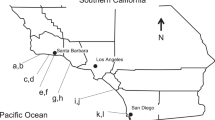Abstract
Male crabs infected by parasitic barnacles (Rhizocephala) are known to be morphologically feminized. Here, we investigate morphological chances in green crabs, Carcinus maenas, induced by the parasitic barnacle Sacculina carcini. Infected males acquire a broader, longer and segmented abdomen, fringed with marginal setae. Copulatory appendages and pereopods are reduced in length, and the chelae become smaller. The feminization show great individual variation. Males with scars from lost externae, the parasites reproductive organ situated under the abdomen, are less modified than males carrying an externa, and the feminization is more pronounced in smaller than in larger males. No super-feminization is evident in female crabs that remain morphologically unaffected by infection. The protective value of a parasitically induced enlargement of the male abdomen may constitute an adaptation that increases parasite longevity. The additional effects on male morphology are viewed as pleiotropic side effects of the main adaptive value of enlarging the abdomen.



Similar content being viewed by others
References
Bulgurkov K (1938) Study of Rhizocephala and Bopyridae from the Bulgarian Black Sea coast. Trudy na Chernorskata Biol Sta. v’Varna 7:69–81
Day JH (1935) The life-history of Sacculina. Q J Microsc Sci 77:549–583
Foxon GEH (1940) Notes on the life history of Sacculina carcini Thompson. J Mar Biol Assoc UK 24:253–264
Galil BS, Lützen J (1995) Biological observations on Heterosaccus dollfusi Boschma (Cirripedia: Rhizocephala), a parasite of Charybdis longicollis Leene (Decapoda: brachyura), a lessepsian migrant to the Mediterranean. J Crust Biol 15:659–670
George AI (1959) Heterosaccus ruginosus (Boschma), a rhizocephalan parasite of the crab Neptunus sanguinolentus (Herbst). J Zool Soc India 11:171–204
Giard A (1886) De l’influence de certains parasitès rhizocéphales sur les caractères sexuels extérieures de leur hôte. C R Hebd Acad Sci 103:84–86
Glenner H, Hebsgaard MB (2006) Phylogeny and evolution of life history strategies of the parasitic barnacles (Crustacea, Cirripedia, Rhizocephala). Mol Phylogenet Evol 41:528–538
Hartnoll RG (1967) The effects of sacculinid parasites on two Jamaican crabs. J Linn Soc (Zool) 46:275–295
Høeg JT (1995) The biology and life cycle of the Rhizocephala (Cirripedia). J Mar Biol Assoc UK 75:517–550
Høeg JT, Lützen J (1985) Crustacea Rhizocephala. Marine invertebrates of Scandinavia 6. Norwegian University Press, Oslo, pp 1–92
Lützen J (1981) Field studies on regeneration in Sacculina carcini Thompson (Crustacea: rhizocephala) in the Isefjord, Denmark. J Exp Mar Biol Ecol 53:241–249
Lützen J (1984) Growth, reproduction and life span in Sacculina carcini Thompson (Cirripedia: rhizocephala) in the Isefjord, Denmark. Sarsia 69:91–106
Matsumoto K (1952) On the sacculinization of Charybdis japonioca (A. Milne-Edwards). Biol J Okayama Univ 1:84–89
Nair NB, Gurumani ON (1956) On the occurrence of three Sacculina parasitising the edible crab Neptunus sanguinolentus. J Bombay Nat Hist Soc 53:730–732
Nielsen S-O (1970) The effects of the rhizocephalan parasites Peltogaster paguri Rathke and Gemmosaccus sulcatus (Lilljeborg) on five species of paguridan hosts (Crustacea: decapoda). Sarsia 42:17–32
Okada YK, Miyashita Y (1935) Sacculinization in Eriocheir japonicus de Haan, with remarks on the occurrence of complete sex-reversal in parasitized male crabs. Mem Col Sci Kyoto Imp Univ B 10:169–208
Øksnebjerg B (2000) The Rhizocephala (Crustacea: cirripedia) of the Mediterranean and Black Seas: taxonomy, biogeography, and ecology. Israel J Zool 46:1–102
Pérez C (1933) Action de la sacculine sur les caractères sexuels extérieures du Pachygrapsus marmoratus. C R Soc Biol Paris 113:1027–1029
Phillips WJ, Cannon LRG (1978) Ecological observations on the commercial sand crab, Portunus pelagicus (L.), and its parasite, Sacculina granifera Boschma, 1973 (Cirripedia: rhizocephala). J Fish Dis 1978:137–149
Potts FA (1909) Observations on the changes in the common shore-crab caused by Sacculina. P Camb Philos Soc 15:96–100
Reinhard EG (1950) An analysis of the effects of a sacculinid pasrasite on the external morphology of Callinectes sapidus Rathbun. Biol Bull Wood’s Hole 98:255–288
Smith G (1906) Rhizocephala. Fauna Flora Golf Neapel 29:1–123
Smith G (1910) Studies in the experimental analysis of sex. Part 3. Further observations on parasitic castration. Q J Microsc Sci 55:225–240
Srinivasagam S (1982) An instance of large scale parasitism of Heterosaccus dollfusi Boschma on the edible crab, Portunus sanguinoletus (Herbst) in Pulicat Lake. J Inland Fish Soc India 14:88–90
Veillet A (1945) Recherches sur le parasitisme des crabes et des Galathées par les Rhizocéphales et les épicarides. Ann I Océanogr Paris 22:193–341
Veillet A, Graf F (1958) Dégénérescence de la glande androgène des Crustacés décapodes parasités par les Rhizocéphales. Bull Mens Soc Sci N 18:123–127
Vernet-Cornubert G (1958) Recherches sur la sexualité du crabe Pachygrapsus marmoratus (Fabricius). Arch Zool Exp Gén 96:101–276
Weng HT (1987) The parasite barnacle, Sacculina granifera Boschma, affecting the commercial sand crab, Portunus pelagicus (L.), in populations from two different environments in Queensland. J Fish Dis 10:221–227
Werner M (2001) Prevalence of the parasite Sacculina carcini Thompson 1836 (Crustacea, Rhizocephala) on its host crab Carcinus maenas (L.) on the west coast of Sweden. Ophelia 55:101–110
Yamaguchi T, Aratake H (1997) Morphological modifications caused by Sacculina polygenea in Hemigrapsus sanguineus (De Haan) (Brachyura: grapsidae). Crust Res 23:89–101
Acknowledgments
We are very grateful to the Carlsberg Foundation for covering all expenses connected with the study (grant no. 2008-01-0491). We also wish to thank the staff of the Danish Shellfish Center, Nykøbing Mors, Denmark, for collecting some of the material and providing laboratory facilities, and Dr. David R. Nash, Section for Social Evolution, Department of Biology, University of Copenhagen, Denmark, for advice and assistance.
Author information
Authors and Affiliations
Corresponding author
Additional information
Communicated by S. A. Poulet.
Rights and permissions
About this article
Cite this article
Kristensen, T., Nielsen, A.I., Jørgensen, A.I. et al. The selective advantage of host feminization: a case study of the green crab Carcinus maenas and the parasitic barnacle Sacculina carcini . Mar Biol 159, 2015–2023 (2012). https://doi.org/10.1007/s00227-012-1988-4
Received:
Accepted:
Published:
Issue Date:
DOI: https://doi.org/10.1007/s00227-012-1988-4




